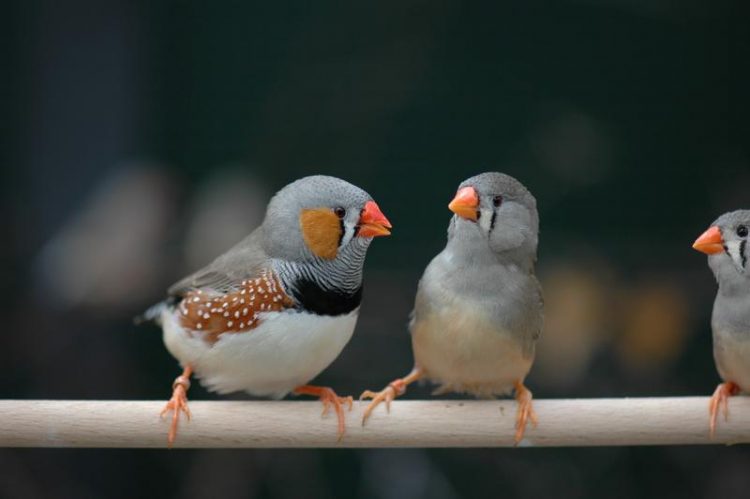Mutation speeds up sperm of zebra finches

Gene inversion gives reproductive advantage to zebra finches Wolfgang Forstmeier / MPI for Ornithology
The “goal” of each sperm is fertilizing the ovum, which implies winning a fierce race through the long female reproductive tract. The competitors in this race are the “sibling” sperm from the same male, but often also sperm from other males. Given such competition and the resulting strong selection, it is inevitable that only the fittest reproduce. In the course of evolution, the best sperm design will thus have prevailed. In a small Australian songbird, the zebra finch, however, scientists have still found sperm of various morphology and velocity.
Together with colleagues from the Czech Republic, researchers from the Max Planck Institute for Ornithology in Seewiesen found that an inversion of a large fragment of the sex chromosome Z is responsible for sperm design, with immediate consequences for sperm swimming speed and hence for fertilization rate and for a male’s reproductive success.
Every male possesses two Z chromosomes, one of which they inherited from the mother and one from the father. Z chromosomes exist in two versions, the regular one (A) and the inverted type (B). “Only if a male possesses both types, meaning that it is heterozygous AB instead of homozygous AA or BB, the male’s sperm show a long midpiece which contains the motor for fast swimming” says Ulrich Knief, first author of the study.
Animals with two identical forms of the Z chromosome (i.e. the homozygous males) cannot produce the superior sperm and hence show lower fertilization rates. The study is based on paternity analyses of 435 males in the absence of sperm competition and another 482 males under competition with other males. The study clearly shows that heterozygous males had higher fertilizing success under both conditions.
The superior sperm of heterozygous males can reduce fertility problems, but heterozygous males will always produce 50% homozygous sons, such that the genetic variation in the population does not get depleted, because the optimal genotype cannot go to fixation. For many years, the evolutionary biologist Wolfgang Forstmeier has been puzzled by the high rates of infertility in this species, asking why evolution seems unable to fix this problem despite strong selection against infertile males.
“This study is a first step into the direction of answering this question” says Forstmeier. “With an inheritance system with two sets of chromosomes, evolution is stuck when only the combination of both creates the perfect genotype.”
While the researchers from Seewiesen were interested in the fitness consequences of the Z chromosome inversion, another group of scientists from the lab of Jon Slate from the University of Sheffield arrived at the same results through a wholly different approach. These scientists examined specific breeding lines of zebra finches, which had been selected for either short or long sperm.
In a genome-wide search for variants affecting sperm morphology they independently discovered the Z chromosome inversion. Their study can thus show that the relevant genetic information for sperm morphology is almost exclusively found on this sex chromosome.
“Rather than being redundant, the studies nicely complement each other by the fact that two research teams arrived at the same conclusion coming from very different approaches” explains Bart Kempenaers, senior author of the study.
Contact:
Prof. Dr. Bart Kempenaers
Max Planck Institute for Ornithology, Seewiesen
Department Behavioural Ecology & Evolutionary Genetics
Phone: +49 172 835 1578
E-Mail: b.kempenaers@orn.mpg.de
Dr. Ulrich Knief
Ludwig Maximilian University of Munich
Division of Evolutionary Biology
Phone: +49 89 2180 74101
E-Mail: knief@biologie.uni-muenchen.de
Publication:
DOI 10.1038/s41559-017-0236-1
Media Contact
More Information:
http://www.orn.mpg.deAll latest news from the category: Life Sciences and Chemistry
Articles and reports from the Life Sciences and chemistry area deal with applied and basic research into modern biology, chemistry and human medicine.
Valuable information can be found on a range of life sciences fields including bacteriology, biochemistry, bionics, bioinformatics, biophysics, biotechnology, genetics, geobotany, human biology, marine biology, microbiology, molecular biology, cellular biology, zoology, bioinorganic chemistry, microchemistry and environmental chemistry.
Newest articles

Properties of new materials for microchips
… can now be measured well. Reseachers of Delft University of Technology demonstrated measuring performance properties of ultrathin silicon membranes. Making ever smaller and more powerful chips requires new ultrathin…

Floating solar’s potential
… to support sustainable development by addressing climate, water, and energy goals holistically. A new study published this week in Nature Energy raises the potential for floating solar photovoltaics (FPV)…

Skyrmions move at record speeds
… a step towards the computing of the future. An international research team led by scientists from the CNRS1 has discovered that the magnetic nanobubbles2 known as skyrmions can be…





















